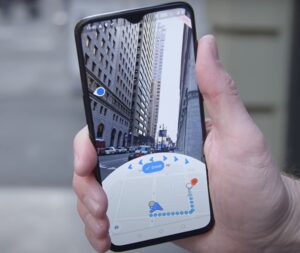Augmented Reality (AR) has rapidly emerged as a groundbreaking technology, seamlessly blending the digital and physical worlds. Unlike Virtual Reality (VR), which immerses users in a completely digital environment, AR overlays digital information onto the real world, enhancing the user’s perception and interaction with their surroundings. This document delves into the multifaceted world of AR, exploring its mechanisms, types, applications, and future potential. As AR technology continues to evolve, it promises to revolutionize various industries and aspects of daily life, making it a pivotal subject for both tech enthusiasts and professionals.
What is Augmented Reality (AR)?
Definition and Explanation
Augmented Reality (AR) refers to the integration of digital information with the user’s environment in real time. Unlike VR, which creates a wholly artificial environment, AR enhances the real world with computer-generated perceptual information, often across multiple sensory modalities, including visual, auditory, and haptic feedback. This enhancement can range from simple overlays, like displaying text and images, to more complex integrations, such as interactive holograms. AR applications are diverse, spanning gaming, education, healthcare, and retail, driven by the growing capabilities of mobile devices and wearable technology.
Brief History of AR
The concept of AR dates back to the 1960s when Ivan Sutherland developed the first head-mounted display system, known as the “Sword of Damocles.” However, it wasn’t until the 1990s that AR gained significant momentum, with advancements in computing power and graphics. The term “Augmented Reality” was coined by Tom Caudell in 1990, and since then, the technology has seen substantial development. The 2000s brought AR to mobile devices, and today, AR is accessible to the masses through smartphones and AR glasses, with notable applications like Pokémon GO and Snapchat filters demonstrating its potential.
How AR Works
Hardware Components
The hardware necessary for AR includes devices capable of real-time data processing and display. Key components include sensors (cameras, accelerometers, GPS), processors, displays (smartphones, AR glasses, headsets), and input devices. Cameras capture the real world, while sensors detect the user’s movements and environment. Processors integrate this data with digital content, and displays project the augmented experience. Advanced AR devices like Microsoft’s HoloLens and Magic Leap incorporate sophisticated sensors and optics to deliver immersive AR experiences.
Software Components
Software is crucial in AR, involving complex algorithms and frameworks to render digital content seamlessly onto the real world. AR software includes development kits (ARKit, ARCore), rendering engines (Unity, Unreal Engine), and specialized algorithms for object recognition, tracking, and spatial mapping. These components work together to interpret sensor data, align digital overlays with real-world objects, and ensure smooth interaction. The evolution of software tools has made AR development more accessible, enabling the creation of diverse applications across various industries.
AR vs. VR
AR and VR are often discussed together but serve distinct purposes. AR overlays digital content onto the real world, enhancing reality without fully immersing the user. In contrast, VR creates a completely virtual environment, isolating users from the real world. AR applications are typically more practical for daily use, offering enhanced navigation, education, and retail experiences. VR, on the other hand, is more suited for immersive gaming, training simulations, and virtual tours. Both technologies have unique strengths and are shaping the future of digital interaction in complementary ways.
Types of Augmented Reality
Marker-Based AR
Marker-Based AR relies on predefined visual markers, such as QR codes or images, to trigger digital content. When a device’s camera recognizes a marker, it overlays the corresponding digital information onto the real world. This type of AR is commonly used in marketing, education, and gaming. The markers serve as anchors, ensuring accurate placement of the digital content. Examples include interactive museum exhibits where scanning a marker reveals additional information or 3D models, enhancing the learning experience.
Markerless AR
Markerless AR, also known as location-based or position-based AR, does not require predefined markers. Instead, it uses the device’s sensors, including GPS, accelerometers, and gyroscopes, to determine the user’s location and orientation. This allows for more flexible and immersive experiences, such as overlaying digital navigation paths in real-world environments or enhancing outdoor activities with interactive elements. Applications like Pokémon GO and Google Maps AR navigation utilize markerless AR to provide engaging, context-aware experiences.
Location-Based AR

Location-Based AR utilizes the geographic position of the user to deliver relevant digital content. By integrating GPS data, this type of AR can overlay information about nearby points of interest, historical landmarks, or retail promotions directly onto the user’s view. This approach enhances travel and exploration, offering real-time data about the surroundings. Apps like Yelp Monocle and Wikitude leverage location-based AR to provide users with enriched information about their environment, enhancing the way people interact with the world around them.
Projection-Based AR
Projection-Based AR involves projecting digital light onto physical surfaces, creating interactive displays without requiring a screen. This type of AR can transform any surface into a dynamic interface, useful for interactive presentations, retail displays, and immersive installations. By using projectors and depth sensors, projection-based AR can create 3D illusions and interactive environments. This technology is often seen in advanced exhibitions and retail spaces where engaging visual experiences are crucial for capturing audience interest.
Applications of AR
Gaming and Entertainment
AR has revolutionized the gaming and entertainment industry by providing immersive and interactive experiences. Games like Pokémon GO and Ingress utilize AR to blend the virtual and real worlds, encouraging physical activity and exploration. In entertainment, AR enhances live events, theme parks, and exhibitions, creating engaging environments where users can interact with digital content. The potential for AR in gaming and entertainment is vast, with future developments likely to include more sophisticated multiplayer experiences and deeper integration with physical spaces.
Education and Training
In education, AR offers innovative ways to engage students and enhance learning. By overlaying digital information onto physical textbooks or classrooms, AR can bring subjects to life, making complex concepts easier to understand. For example, medical students can use AR to visualize anatomy in 3D, and history lessons can be enriched with interactive timelines. In professional training, AR provides realistic simulations for skills development, such as pilot training or machinery maintenance, reducing risks and costs associated with traditional training methods.
Healthcare
AR is transforming healthcare by improving diagnosis, treatment, and patient care. Surgeons use AR to visualize complex anatomy during procedures, enhancing precision and outcomes. Medical imaging, such as MRI and CT scans, can be overlaid onto patients, providing a comprehensive view for diagnosis. AR also aids in patient education, allowing doctors to explain conditions and treatments through interactive 3D models. Additionally, AR is used in rehabilitation, offering gamified exercises that motivate patients to adhere to their recovery programs.
Retail and E-Commerce
In retail, AR enhances the shopping experience by allowing customers to visualize products in their environment before making a purchase. Virtual try-ons for clothing, accessories, and makeup help customers see how items look without physical trials. Furniture and home decor apps use AR to show how products will fit and look in a customer’s space. E-commerce platforms are increasingly adopting AR to provide detailed product views and interactive experiences, driving higher engagement and conversion rates.
Real Estate
AR is revolutionizing real estate by offering virtual property tours and interactive architectural visualizations. Prospective buyers can explore homes and commercial spaces remotely, with AR providing detailed information and contextual overlays. Architects and builders use AR to visualize construction projects, identifying potential issues before they arise. This technology streamlines the design and buying process, making it easier for clients to make informed decisions and for professionals to present their work compellingly.
Industrial and Military Applications
In industrial settings, AR enhances efficiency and safety by providing workers with real-time information and instructions. Maintenance and repair tasks benefit from AR overlays that guide technicians step-by-step, reducing errors and downtime. In manufacturing, AR aids in assembly processes and quality control. The military uses AR for training simulations, situational awareness, and mission planning, providing soldiers with crucial information and enhanced decision-making capabilities in the field.
AR in Daily Life
AR Apps and Gadgets
AR has become increasingly integrated into daily life through a variety of apps and gadgets. Smartphones are the primary medium, with apps for gaming, navigation, and social media incorporating AR features. Wearable devices like AR glasses offer hands-free interaction, enhancing productivity and accessibility. Everyday applications include virtual home decor previews, fitness apps with interactive workouts, and educational tools that enrich learning experiences. The convenience and versatility of AR technology continue to drive its adoption in everyday activities.
Social Media and AR
Social media platforms have embraced AR to enhance user engagement and creativity. Filters and lenses on apps like Snapchat, Instagram, and TikTok allow users to augment their photos and videos with dynamic effects, animations, and virtual objects. These AR features have become integral to social media interactions, enabling users to express themselves in new and imaginative ways. Additionally, brands use AR in social media campaigns to create interactive and memorable experiences, driving user interaction and brand loyalty.
The Future of Augmented Reality
Technological Advancements
The future of AR is poised for significant advancements driven by improvements in hardware and software. Innovations in display technology, such as lightweight AR glasses and contact lenses, will make AR more accessible and comfortable for extended use. Advances in artificial intelligence and machine learning will enhance AR’s ability to understand and interact with the real world, providing more accurate and context-aware experiences. The integration of 5G technology will enable faster data processing and real-time interactions, expanding the possibilities for AR applications.
Potential Challenges
Despite its promising future, AR faces several challenges. Privacy concerns arise from the extensive data collection and environmental scanning required for AR functionality. Ensuring user privacy and data security is paramount. Technical challenges include the need for high processing power, battery efficiency, and seamless integration of digital content with the physical world. Additionally, there are social and ethical considerations regarding the impact of AR on daily life, such as the potential for addiction or the blurring of reality and virtual content.
AR and the Metaverse
The concept of the metaverse, a collective virtual shared space, is closely tied to the future of AR. AR will play a crucial role in bridging the physical and digital worlds within the metaverse, enabling users to interact with virtual environments in their real-world surroundings. This integration will create new opportunities for social interaction, commerce, and entertainment, transforming how people live, work, and play. As the metaverse evolves, AR will be a key technology in shaping this interconnected digital ecosystem.
Conclusion
Augmented Reality is reshaping the way we interact with the world, offering new dimensions of information, entertainment, and utility. From enhancing everyday tasks to revolutionizing industries, AR’s potential is vast and ever-expanding. As technology advances, artificial intelligence (AI), and AR will become even more integrated into our lives, creating richer and more immersive experiences. Embracing AR means staying at the forefront of innovation, ready to explore the limitless possibilities of a world where digital and physical realities converge.


